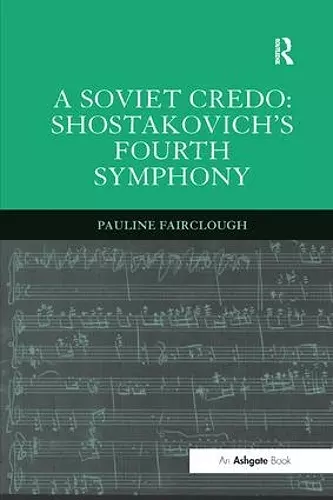A Soviet Credo: Shostakovich's Fourth Symphony
Format:Paperback
Publisher:Taylor & Francis Ltd
Published:15th Nov '16
Currently unavailable, and unfortunately no date known when it will be back
This paperback is available in another edition too:
- Hardback£150.00(9780754650164)

Composed in 1935-36 and intended to be his artistic 'credo', Shostakovich's Fourth Symphony was not performed publicly until 1961. Here, Dr Pauline Fairclough tackles head-on one of the most significant and least understood of Shostakovich's major works. She argues that the Fourth Symphony was radically different from its Soviet contemporaries in terms of its structure, dramaturgy, tone and even language, and therefore challenged the norms of Soviet symphonism at a crucial stage of its development. With the backing of prominent musicologists such as Ivan Sollertinsky, the composer could realistically have expected the premiere to have taken place, and may even have intended the symphony to be a model for a new kind of 'democratic' Soviet symphonism. Fairclough meticulously examines the score to inform a discussion of tonal and thematic processes, allusion, paraphrase and reference to musical types, or intonations. Such analysis is set deeply in the context of Soviet musical culture during the period 1932-36, involving Shostakovich's contemporaries Shebalin, Myaskovsky, Kabalevsky and Popov. A new method of analysis is also advanced here, where a range of Soviet and Western analytical methods are informed by the theoretical work of Shostakovich's contemporaries Viktor Shklovsky, Boris Tomashevsky, Mikhail Bakhtin and Ivan Sollertinsky, together with Theodor Adorno's late study of Mahler. In this way, the book will significantly increase an understanding of the symphony and its context.
’...Musical examples are extensive and the modified Schenker graphs useful...The bibliography and index are excellent... Recommended.’ Choice '... adds to the still scarce body of knowledge about this composition... a valuable historical-aesthetic analysis.' Tempo ’Pauline Fairclough's study tackles head-on the work's analytical and hermeneutic challenges and offers a stimulating [...] guide to the Fourth Symphony's complexities... a useful model for historically informed writing about Shostakovich and his music.' Notes ’... extremely detailed analysis of the four movements of the Fouth Symphony... the overall impressions conveyed by the book being its thought-provoking nature and the vivid depiction of the intellectual, cultural and political embroglio surrounding Shostakovich during the crucial years of the mid-1930s.’ Fontis Artis Musicae ’... Fairclough goes much into the detail of the music of the symphony... This extended second [...] part of the book, written with meticulous accuracy, should be recommended to any Shostakovich scholar, any student in the field of Russian music and everybody interested in the development of the twentieth-century symphony in general... Fairclough's book is full of well-argued ideas and it is written with considerable analytical skills.’ Slavonic and East European Review ’Pauline Fairclough’s study of Shostakovich’s Fourth Symphony is a most welcome and necessary addition to Shostakovich scholarship, and it fills a surprising gap in research on a composition that not only occupied a place of enormous personal importance to its composer, but remained perhaps his most ambitious work. ... an impressive achievement in Shostakovich scholarship. Her book will surely remain a key text for many years to come and is be recommended to all who wish to probe deeper into this crucially important work.’ Music and Letters
ISBN: 9781138264700
Dimensions: unknown
Weight: 453g
296 pages